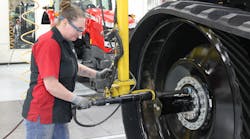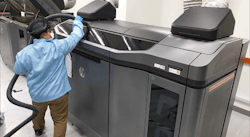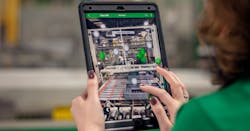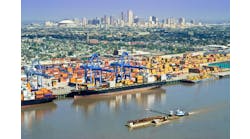Sometimes we don’t ask the right questions.
Will innovative technology catch the attention of young talent and bring them to manufacturing’s doorstep? While the question and sentiment are valid, it’s really a case of missing the forest for the trees.
Technology is intrinsic to the lives of millennials and Gen Z. It is how they communicate and socialize, and it is increasingly how they perform their jobs. Therefore, the real question that needs to be posed is not which type of technology is going to attract them to the field, but instead how can technology be used to give them the careers they want.
“Students, and especially engineers, all have the same desire,” says Dan Gamota, vice president of manufacturing technology and innovation for Jabil Inc. “They want to change the world.”
Making a difference in the world is in fact a strongly held belief of the 90 million people who comprise Gen Z (born after 1997 to about the early 2010s). And technology, including augmented reality, which offers a digital overlay of real assets, and virtual reality, which exists entirely in a virtual world, can become the foundation upon which those desires are realized.Engineers at Jabil’s Singapore facility, using AR for training on 3D-printer operations, have reduced training time from four weeks to two.Jabil Inc.
How so? Both technologies can offer companies an edge when it comes to training, which is a key component of career satisfaction. Augmented reality enables the gathering of experience and data that can be turned into instructional videos, for example, which are then uploaded to wearables. It’s an efficient and, for many, enjoyable way to transfer knowledge.
“One of our long-term employees has become quite the video star,” explains Gamota. “Younger workers admire his skills and are using his know-how as part of their training. It’s been great to see the interaction and enthusiasm between the different generations of workers.”
These methods are paying off in terms of efficiency and cost. At Jabil’s Singapore facility, engineers in the Additive Manufacturing Center use AR to streamline training on 3D-printer operations. Prior to deploying AR, it took four weeks for a lead engineer to train a new operator. With AR, training time is narrowed to two weeks and the presence of engineers isn’t required.
AGCO, a manufacturer of agriculture equipment based in Georgia, also experienced reductions in the time it took employees to learn new skills. The company uses AR and mixed reality via Glass for Enterprise at some of its facilities. At a pilot facility the results have been dramatic, with a 50% reduction in the learning-curve duration. Defects have also been reduced by 50% during the learning-curve period.
Interestingly, using AR in training wasn’t something AGCO had counted on when it adopted the technology in 2014 as part of its broader IoT solution that used AR for quality and assembly. “Once you know how to use this tool, it can be applied to any job on the floor,” says Peggy Gulick, AGCO director of digital transformation.
In fact, Gulick says the glasses now are part of workers’ uniforms. They wear gloves, helmets, ear protection and glasses. Gulick points out that AGCO’s products are very complex, and the ability to use AR to have all the information on a particular machine available—at a personal skill level—is especially important. It is this seamless integration of tools and technology that enables workers to become more competent at their jobs.
“No one wants to make mistakes,” says Gulick. “This is the value this technology offers. It gives everyone the opportunity to do things correctly.”
AR has brought a range of benefits to AGCO. The technology has reduced the length of time workers spend walking the floor to seek assistance, and it’s enabled remote work requiring expert advice to become more efficient. Waiting for assistance at remote locations is not necessary, as the wearable can receive instructions as though a colleague were looking over a worker’s shoulder.
Bringing in technology that improves how employees do their jobs is essential to both attracting and retaining workers. “Our employees are seeking to drive value,” says Gulick. “Long-term employees see immediately how this new technology can makes things much easier and improve efficiency. They have a point of comparison as to how things were done and how they are done now.”
Augmented Reality in the Standard Toolkit
Improving processes is how Schneider Electric is employing AR both at its facilities and those of its clients. “While many people thought of AR as a gimmick, it’s now part of a standard toolkit that is integrated into our ecosystem,” explains Luke Durcan, director of EcoStruxure at Schneider Electric.
“While many people thought of AR as a gimmick, it’s now part of a standard toolkit that is integrated into our ecosystem,” explains Luke Durcan of Schneider Electric.Schneider Electric
One especially useful benefit of this technology is the ability to create standardized work processes. Bühler, a global developer of equipment for processing foods, used Schneider’s EcoStruxure to dramatically improve the way machine operators are trained. For example:
- The technology helps facilitate a product line switchover by demonstrating visually to operators a step-by-step approach for executing any new procedures.
- The augmented reality tools ensure that the right steps are completed in the right order.
- Information is sent back to a centralized server and is available as a management report that indicates which operators reviewed the new procedures, documents when they executed the tasks, and confirms whether the execution of steps was successful or not.
In addition to training, Bühler uses augmented reality to prompt employees on tasks in a consistent manner across all of its factories, thereby reducing human error. When updates to operational procedures are made, changes are automatically pushed out to the entire workforce so that everyone is instantly up to speed regarding the latest procedures.
The benefits these companies are seeing from AR has attracted the attention of other manufacturing companies. According to a recent study from Grid Raster, a company that works with manufacturers in automotive, aerospace and defense manufacturing to launch AR/VR solutions, 56% of those polled have used some form of the technology in the past year. More than a quarter (27%) have fully deployed an AR/VR solution and are looking to scale further.
While 26% of the companies use the technology for training programs, 60% use it to supplement labor on production lines.
“The return on investment on this technology is strong,” says Rishi Ranjan, CEO of Grid Raster. The study showed that 29% are realizing more than a 25% increase in productivity efficiency. Regarding cost, 61% report seeing a 20% cost savings as a result of leveraging AR/VR technologies.
Building Culture Through Technology
While ROI is an important measurement of success, there are other benefits. Durcan points to the technologies’ ability to build a stronger company culture. “In our factories, we are always a team,” he says. “While many older workers are not thrilled about passing on skills to the next generation, that’s not the case in manufacturing.”
“Our veteran workers want to share their knowledge, and this technology is a great way to do that. The experienced workers can demonstrate how things work to the younger workers. The collaboration between the generations works well,” he adds.
Training and eventually upskilling is how AR will continue to provide value to workers. Using data analytics delivered through AR and other technologies, workers are able to acquire additional skills and advance their careers. The ability to see a career development path is a key component for the next generation in choosing employers.
Another imperative for Gen Z is the ability to work in diverse environments. AR can enable this. “With the glasses, someone wouldn’t have to have a manufacturing background since AR can train them on the job in a way that is personalized to how they learn,” explains Gulick. “This then opens up an opportunity to recruit more women, and other diverse talent, into the field. “
However, at the end of the day, as Gamota explained, the younger generation wants to make an impact on the world.
Jabil has figured out a way to provide this through its internship program, which utilizes innovative technologies in the projects students work on. “We understand the competition for talent, so we make sure our interns, and potential employees, are engaged in meaningful activities,” says Gamota. “But it’s deeper than that. They are able to use their ideas on actual products. At the end of an internship they are able to say, ‘I made an important contribution. I helped build this product.’”
And that project, might very well, help save the world.
(Caption for top photo: At AGCO, a manufacturer of agricultural equipment, augmented reality has enabled workers to become better at their jobs.)






